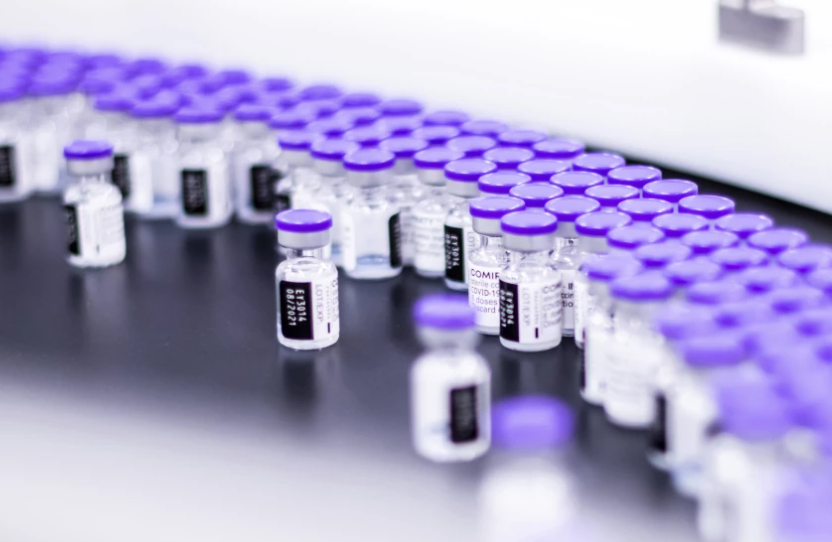Your donation will support the student journalists of Clayton High School. Our goal is to ensure every student and faculty member receives a print copy, and that we can continue to explore interactive storytelling mediums on this platform. Your donation also helps provide us with necessary equipment.
The Pfizer Booster Awaits
When will the boosters arrive at CHS?
November 13, 2021
Back in the spring of 2021, the majority of sophomores and upperclassmen received two doses of the Pfizer-BioNTech COVID-19 vaccine at CHS. By partnering with the Sinks and Medley Pharmacy, students were sufficiently able to receive their vaccines on campus.
People who received their vaccines in the spring transitioned into summer break with plenty of protection from the virus. However, protection decreases over the time elapsed since an individual has received their one or two doses of the vaccine, depending on which pharmaceutical company they received their vaccines from.
Shortly after low quantities of cases were recorded in June at around 15,000 per day, these numbers skyrocketed to almost 200,000. The more contagious Delta variant caused this outbreak, affecting 83% of new cases across the nation. As of October 2021, the U.S. is only experiencing half of the statistics recorded in the second half of the summer.
As mentioned earlier, protection from viruses is constantly decreasing after receiving the vaccine. So, as time passes since getting it, the risk of contracting the virus increases, even if you’re fully vaccinated. Thus, only 57.6% of the American population is fully vaccinated, so it’s possible that those who aren’t vaccinated may be the ones who caused the major outbreak in the first place.
Over the summer, unvaccinated young people filled up ICU sections in hospitals, so their choice of not getting the vaccine was what put themselves at a potential risk of dying from COVID-19. Despite this, people who have gotten their vaccine in late 2020 or earlier this year are beginning to develop symptoms to eventually catching the virus, simply because these vaccines do not have the strength to fully protect against disease.
Although vaccines like Pfizer and Moderna are said to be at least 90% effective, the time the vaccine would last was anonymous. Initially, the two companies said that they offer 90% protection against cases of disease, which might become 70% after six or seven months. Because of the dramatic and rapid increase in cases throughout the month of July, there’s clear evidence that these vaccines aren’t enough to completely protect against the virus. In other words, they cannot last such a long time. The fact that this happened drew pharmaceutical companies to developing boosters. For right now, Pfizer is the first and currently the only company to do so.
This third vaccine is called a “booster” to increase protection against disease after the time elapsed since being vaccinated is decreasing overall protection. However, the booster is quite similar to the first two doses of the vaccine, but an additional third dose to increase immunization against COVID-19 after it slowly decreased through some time.
“Currently, the CDC recommends a booster to those that qualify and their 2nd dose has been 6 months ago or more,” said Clayton nurse coordinator Heather Christman. However, people who are currently qualified are those who live and work in a high-risk environment. All senior citizens (Age 65+) in the U.S. are absolutely eligible to receive the booster, but not everyone who is at least 18 years old can receive the booster.
As of October 2021, the following people who are at least 18 years old and can receive the booster: those who live in long-term care facilities, have underlying medical conditions, live and work in high-risk settings. People who are considered to work in high-risk settings include dentists, frontline healthcare workers, and respiratory therapists. People who have the ability to work from home are in a low-risk setting because they’re not being exposed to individuals who are somewhat likely to spread the virus through the public.
Symptoms may be experienced from the booster, including headache, fatigue, nauseous, dizziness, and even a fever, but these symptoms can evade as quickly as they appeared. “[After] about 12 hours of not feeling well, Tylenol and ibuprofen pretty much took care of it,” said Christman.
Students throughout the Clayton district are learning in the building without the option of learning from home. Once Clayton schools began following a hybrid schedule, students had the option to learn in person or remote. This school year, remote learning has been taken away. Even though students have received the vaccine more recently than teachers, neither students nor teachers are fully protected because after a period of time, the vaccine is waning.
Some teachers are actually in the process of getting their booster shot, even though they aren’t really eligible yet. There’s a lot of uncertainty in when, and if students will receive their third dose, which will likely be sometime in early 2022. The whole district, as well as the rest of the world, should be focused on accomplishing the goal of ending the pandemic and avoid any cause and effect actions to stop the spread.
Not only can this be achieved not only by getting vaccinated, but also by wearing face masks when needed. “The mask, social distancing and good hand hygiene has helped slow the transmission of the virus,” said Chistman, “we need to continue wearing [masks] because we have family members and friends that don’t qualify to get vaccinated yet.”

